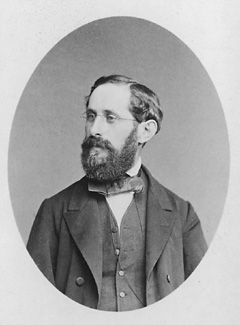Eduard Heine facts for kids
Quick facts for kids
Eduard Heine
|
|
|---|---|

Heinrich Eduard Heine
|
|
| Born | 16 March 1821 |
| Died | 21 October 1881 (aged 60) |
| Nationality | German |
| Alma mater | University of Berlin |
| Known for | Uniform continuity Heine–Borel theorem |
| Awards | Gauss Medal |
| Scientific career | |
| Fields | Mathematician |
| Institutions | University of Bonn University of Halle |
| Doctoral advisor | Enno Dirksen Martin Ohm |
| Influences | Peter Gustav Lejeune Dirichlet |
Heinrich Eduard Heine (born March 16, 1821 – died October 21, 1881) was an important German mathematician. He is known for his work in different areas of math, especially with special functions and real analysis. He also wrote a famous book about spherical harmonics and Legendre functions. Heine also studied basic hypergeometric series and created the Mehler–Heine formula.
Contents
Eduard Heine's Early Life and Education
Heinrich Eduard Heine was born in Berlin, Germany, on March 16, 1821. He was the eighth child of Karl Heine, a banker, and Henriette Märtens. Eduard was first taught at home. Later, he went to two different schools in Berlin.
In 1838, after finishing school, he started studying at the University of Berlin. But he soon moved to the University of Göttingen. There, he attended math classes taught by famous mathematicians like Carl Friedrich Gauss and Moritz Stern.
Returning to Berlin and Getting His PhD
In 1840, Heine went back to Berlin. He continued his math studies with Peter Gustav Lejeune Dirichlet. He also took classes from Jakob Steiner and Johann Franz Encke. In 1842, he earned his PhD (a high university degree) from the University of Berlin. His special paper was about differential equations, which are equations that describe how things change. He dedicated this paper to his professor, Gustav Dirichlet.
After this, Heine went to the University of Königsberg. He joined a special math group led by Carl Gustav Jacob Jacobi. He also learned about mathematical physics from Franz Ernst Neumann. In Königsberg, he met other students who would become famous, like Gustav Kirchhoff and Philipp Ludwig von Seidel.
Heine's Career as a Professor
In 1844, Eduard Heine started teaching at the University of Bonn. He became a privatdozent, which means he was an unpaid university lecturer. He continued his math research there. In 1848, he was promoted to an extraordinary professor, which is like a junior professor.
Life in Halle
In 1850, Heine married Sophie Wolff. She was the daughter of a merchant from Berlin. They had five children together: four daughters and one son.
In 1856, Heine moved to the University of Halle as a full professor. This is a senior teaching position. He stayed there for the rest of his life. From 1864 to 1865, he was the rector of the university, which means he was its head.
In 1875, the University of Göttingen offered him a math job, but he chose to stay in Halle. In 1877, he received the Gauss Medal for his math research. This was a special award given during the 100th birthday celebration of Carl Friedrich Gauss. Eduard Heine passed away in Halle on October 21, 1881.
Important Math Ideas Connected to Eduard Heine
Eduard Heine made many important contributions to mathematics. Some ideas and theorems are named after him.
- Basic hypergeometric series: A special type of math series.
- Heine–Borel theorem: An important idea in real analysis about sets of numbers.
- Heine–Cantor theorem: Another key theorem about continuous functions.
- Heine definition of continuity: A way to understand what a continuous function is.
- Heine's Reciprocal Square Root Identity: A specific math identity.
- Heine–Stieltjes polynomials: A type of polynomial in math.
See also
 In Spanish: Eduard Heine para niños
In Spanish: Eduard Heine para niños

